Winston's take: Bass On The Fly
I recently read a “must do" article for Bass fishing on the fly and watched an older video that put tournament gear fisherman along side a fly guy in the Sacramento Delta. Both were very informative. I thought I’d write up something since I can’t just copy and paste the "must do" article and slap my name to it and my movie-making carrier is a long ways off. I’ll give my take on what I’ve learned in my years of fly fishing for Bass and more recently guiding for them with All Water Guides here in Austin Texas. We seem to have a unique thing going on here in Texas. We target Bass in a manner more similar to salt water fishing than fresh. We row our goofy jet boats as if they were drift boats on some western river. River Bass bring an element of challenge to the table that requires a well-rounded angler. Here are my thoughts…a few of them at least.
1: This is work!
As Brian “Lucky” Porter said in the movie "Zero 2 Hero" about fishing for musky… "You’re not gently presenting a number 14 parachute Adams to a rising trout, you’re doing work.” Now, we're not catching Musky but we do work! I prefer 8wts to 6’s and can realistically expect to hit the bank every 5 feet for hours. We need to put the fly on the bank with S.W.A.T. team like presentation then start fishing it. Once that fly hits the water you need to retrieve it in a "come and get me Mr. Bass manner." Bass in our rivers are aggressive and they want to hunt. When I have anglers on my boat that understand this, we do well, fish practically jump in the boat. But it is work and it’s intense. If you’ve been dead drifting terrestrials with 4wts and haven’t spent much time with bigger gear, ask for a little help. After all it’s just a fly rod and feathers. Line loads the rod and the rod reciprocates that back into the line. I love trout fishing but Bass aren’t trout and our Bass are big, aggressive and live on treadmills. So eat your Wheaties and be ready to do a lot of casting with big gear. Regarding the retrieval, sometimes the fish want it fast or sometimes slow. Find a cadence that you can reproduce. It’s easier to deviate from a constant, meaning if what your doing isn’t working, know what isn’t working so you can slow it down or speed it up.
2: We're fly fishing not casting. Fish every cast.
Just today I had this conversation with a client. He hadn't fished in a year and was rusty. His casts were less than perfect but probably better than most. Again and again he'd pick up a perfectly fishable cast that he didn't think was good enough. There is no such thing as a bad cast on my boat. If that fly hits the water you're fishing, make the most of it. It's become my mantra (I have many) while on the oars, to say, “Fish that cast” meaning exactly that. What you may think is a horrible cast and it probably was (I’m a terrible caster I don’t mind saying it) that fly is in the water and that’s where the fish are, so leave it and start fishing. I think a problem with folks sometimes (and again, me included) is we spend way too much time re-casting a perfectly good and fishable presentation because of what we thought of our cast. As Xienie in the movie "Low and Clear" states, “Ugly casts catch fish too.” After all we’re fishing not casting.
3: They ain't always on the surface.
I’m a weirdo and any one that knows me will not argue that point. I like streamer fishing, not sure why but I do. I don’t fall in the group of anglers that say “nothing like top water action." Don’t get me wrong - it’s a blast, I however would much rather throw big shad patterns on a sinking line any day. To each their own though. I am in the business of putting clients on fish and when the frogs are singing and the conditions call for its poppers…poppers…poppers. The other 99% of the time you gotta do what the river tells ya. Get your head out of the boat and watch what’s happening around you. If you’re not seeing action on the surface go to where the fish are. I’ve had folks in my boat mention “those Bass Masters” and their “glitter boats with all those rods” in a typical fly fisherman manner. What they don’t get is all those rods allow them to, in a systematic manner, dissect the water column. What they also don't get is those dudes catch fish and we could learn a lot from them. When I go fishing I’ve got at least 2 rigged rods, surface and sub surface. I think 2 could easily be 4 though. Surface, sink tip, intermediate and full on get down and dirty depth finders. If having multiple rods doesn't fit the budget purchase some spools. If the fish don’t come to you go get them. If you feed them they will eat.
4. Your confidence fly.
One of my more recent clients while fishing stated, “Winston, I just don’t have any confidence in this fly.” I could have hugged him! It was a good fly, one of my go to flies that always produces. He didn’t like it and that was it, out came the pliers and the fly box. Fish with what you’re confident in. In the subconscious of your deep inner fishing-ness it matters and the fishing will get better. This could be a touchy subject if you’ve hired a guide to fish water that he knows like the back of his hand. I get that and have been there. He’s the guide and who are we to tell him what we want to fish? I don’t think the fish care so neither should the guide. At the end of the day it’s your time on the water. If you're not excited about what you're throwing, our fishing (the actual act of fishing) will suffer. In a professional manner I handed the client my fly box, he picked a fly and on it went. We still got skunked but his whole essence changed by fishing a fly he had confidence in. That, I feel, is as important as fly selection. Listen to your guide but also interact with your guide.
5. Be systematic, be vocal.
I try to always verbalize my ideas with whoever is rowing while I’m fishing and vice versa. This gets the boat working like a team. With clients I try to take a second as the river transitions to clue them in on what lies ahead and open them up to the marvelous thoughts that may or may not be running through my head at the time. I know it’s just fishing but having everyone on the same page really helps. It truly can be a team sport and systematically approaching a section of water and picking it apart as a team is as simple as coming up with a game plan and sticking to it. Fish the water in a manner that will produce more chances of hooking up. Don’t cast over spots 1, 2 and 3 for that fish that "just has to be" hiding in spot 4. Be patient. You never know what bruiser you could be casting over and longer casts have a lower success rate hook set wise. Be systematic, be deliberate and be calculating like the WBD (Weapon of Bass Destruction) you are.
6. Take a break.
Sometimes you get in that grove. Your loops are tight; that fly is kissing the bank and you haven’t hit a tree in an hour… the world is right. Sometimes it’s like this all day; sometimes you lose that magic though. When this happens to me it’s time to get on the oars. I’ve never been able to “will” my way back into the magic. Instead my cast falls apart and I get frustrated and the fishing starts to suck. Take a break. Sit down; tell some more lies about the Yellowstone or throw ice cubes at your buddy if you’re out with one, snap some pictures or smoke a joint. Just stop. Smell the roses (or whatever) and break that cycle. Rest for a minute or 30 and get back after it. We’ve got all the time in the world to fish with focus and intensity and none to waste on being frustrated that our cast has all of a sudden gone to hell. Put the rod down, your muscles will know what to do when you pick it back up. Our brains get in the way sometimes.
NO TROUT SETTING
7. No trout setting, rod tips in the water.
This could also be a mantra... I’m guilty as all hell about the trout setting thing too especially after I've been guiding a lot and haven't fished much. Rod tip on the water and pointing in the direction of the fly keeps the fly where it needs to be and slack line to a minimum. Whether it’s a popper or streamer it’s all about the initial grab and your strip set. Sure fish will be lost but if your fishing for Bass (or Redfish etc. etc) keep that rod out of the picture for now, it’s made to bend for casting purposes definitely not hook setting. Use that line instead. Tip down, rod butt out in front of you and strip set that hook. The salt guys have been preaching this for a long time and so have we. Once you’re tight, fight that fish in the normal manner. I’m not a huge fan of the rod up at a 45-degree angle all the time; I tend to keep my rod low using lots of lateral pressure on the fish, which also helps when they jump. Oh and Bass jump, it’s a predictable event though. They are deep, then less deep, then lesser deep, just like Tarpon (without the Tarpon) bow to the king of fresh water or Mr. Bass will throw that fly right back at you when he goes maverick. Be aggressive landing Mr. Bass and don’t worry about the reel, if that fish needs to be on the reel he’ll put himself there.
As always take it or leave it, I had fun writing it. Get out there and get you some ditch pickles…
Winston Cundiff
All Water Guides
Jet Sled version 2 second edition
how to park a let sled on the river
So here it is. I’m actually glad my laziness got the better of me as I’ll be able to do this in one sitting versus boring you all to tears with each individual step. I assumed this would take much longer than it did.
First picture of my new boat. About 30 seconds later my wife was informed of our new purchase.
After a bunch of research I decided on a SeaArk 1652 MVT (tunneled hull version). 16’ seemed about the right amount of boat, length wise and the wider the better. The decision to go with SeaArk was made after talking to several smaller boat builders in the Midwest, as they all seemed to, at some point in the conversation compare their boats to SeaArks in build, materials, etc. Alvin and JD had already made a couple trips to Currant River Marine (CRM) and under their advice I called Freddy to see what he had available. Long story short I was soon on my way to Currant River Marine in Doniphan, MO with my engine in the back of the Xterra. After a 16 hour drive they hung the engine, we ran the Currant River for a few minutes, and I signed some paperwork. By 5pm I was checked in to a cheap hotel ready to get a zero dark thirty start for the 16 hours back to Austin.
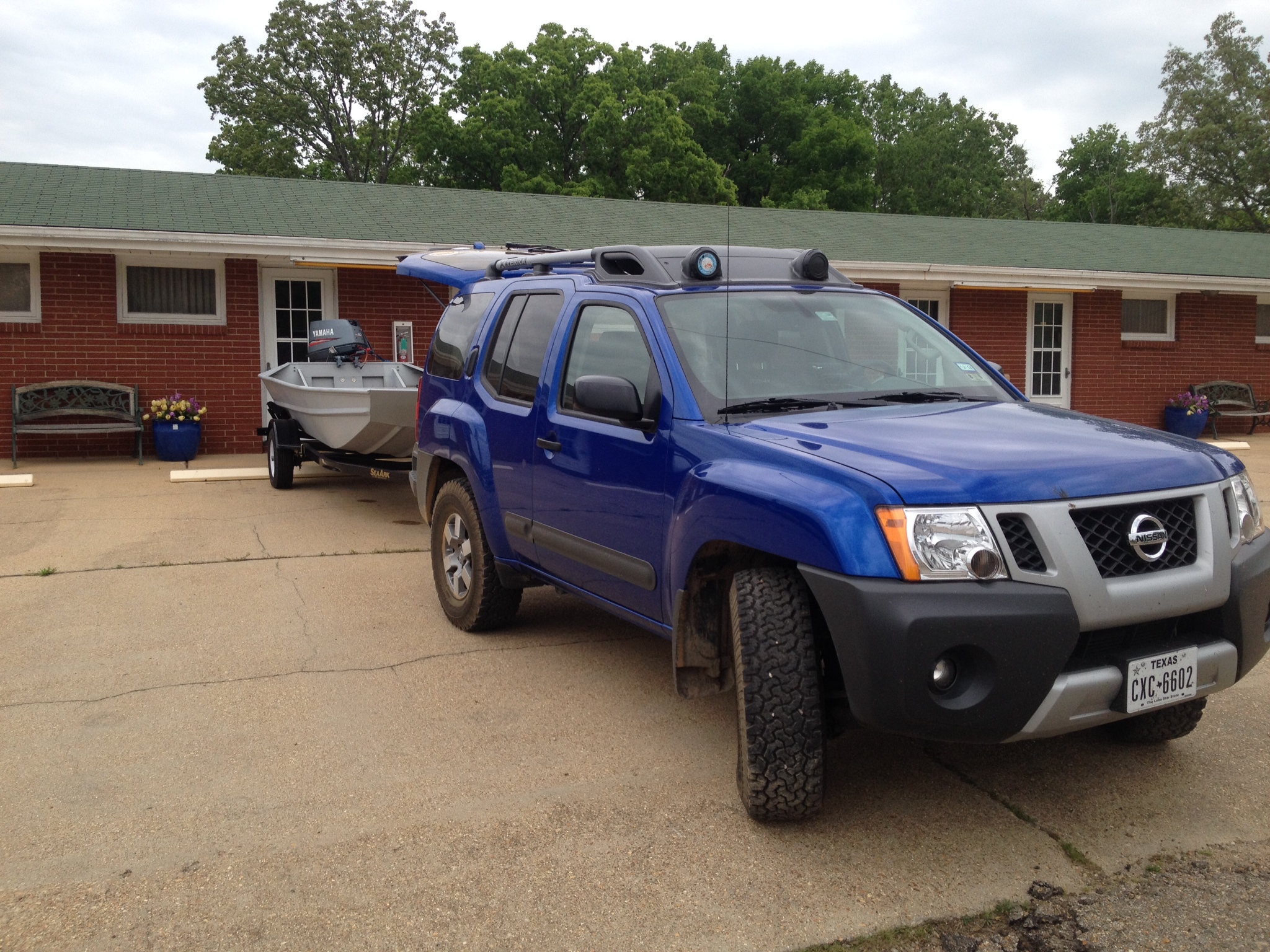
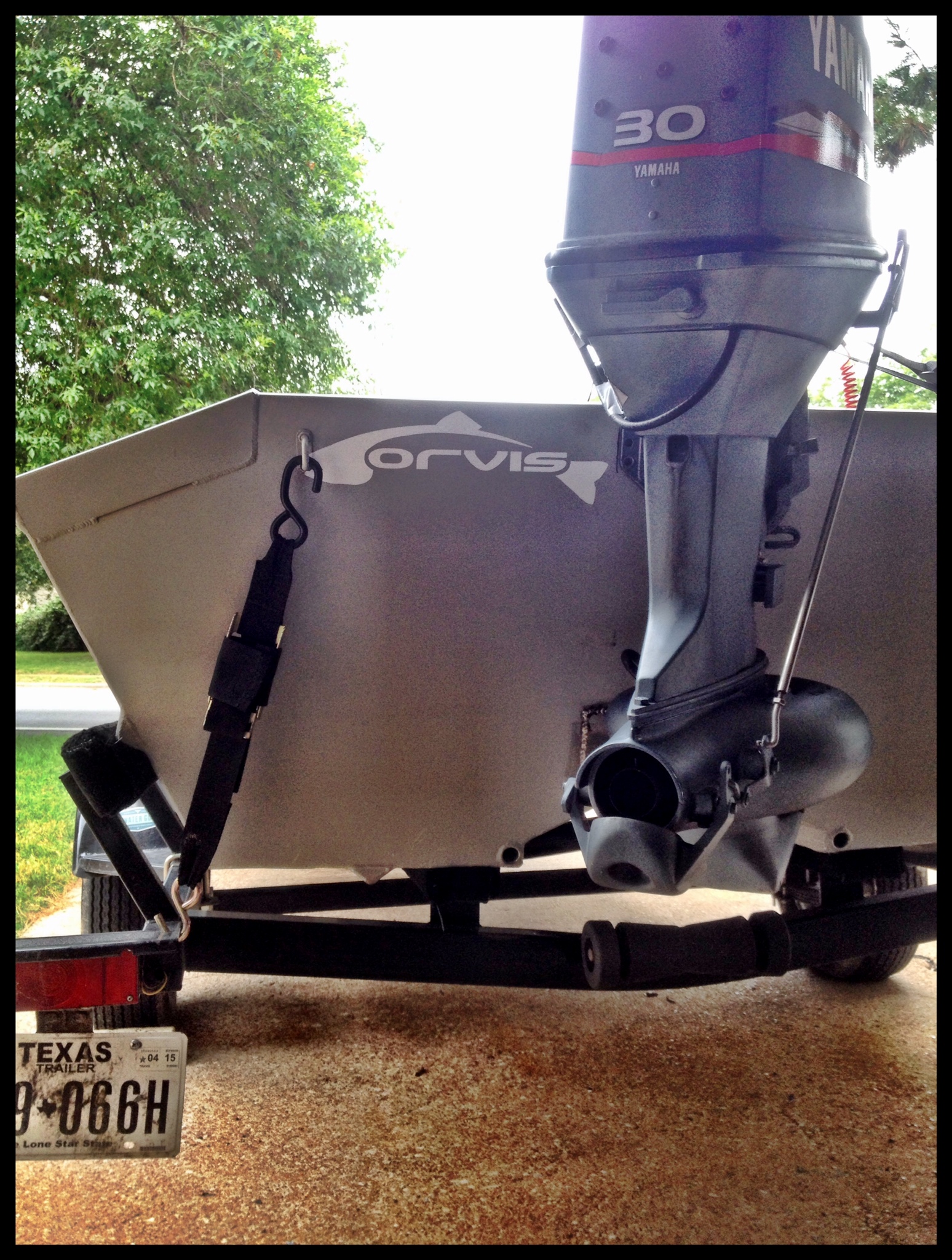

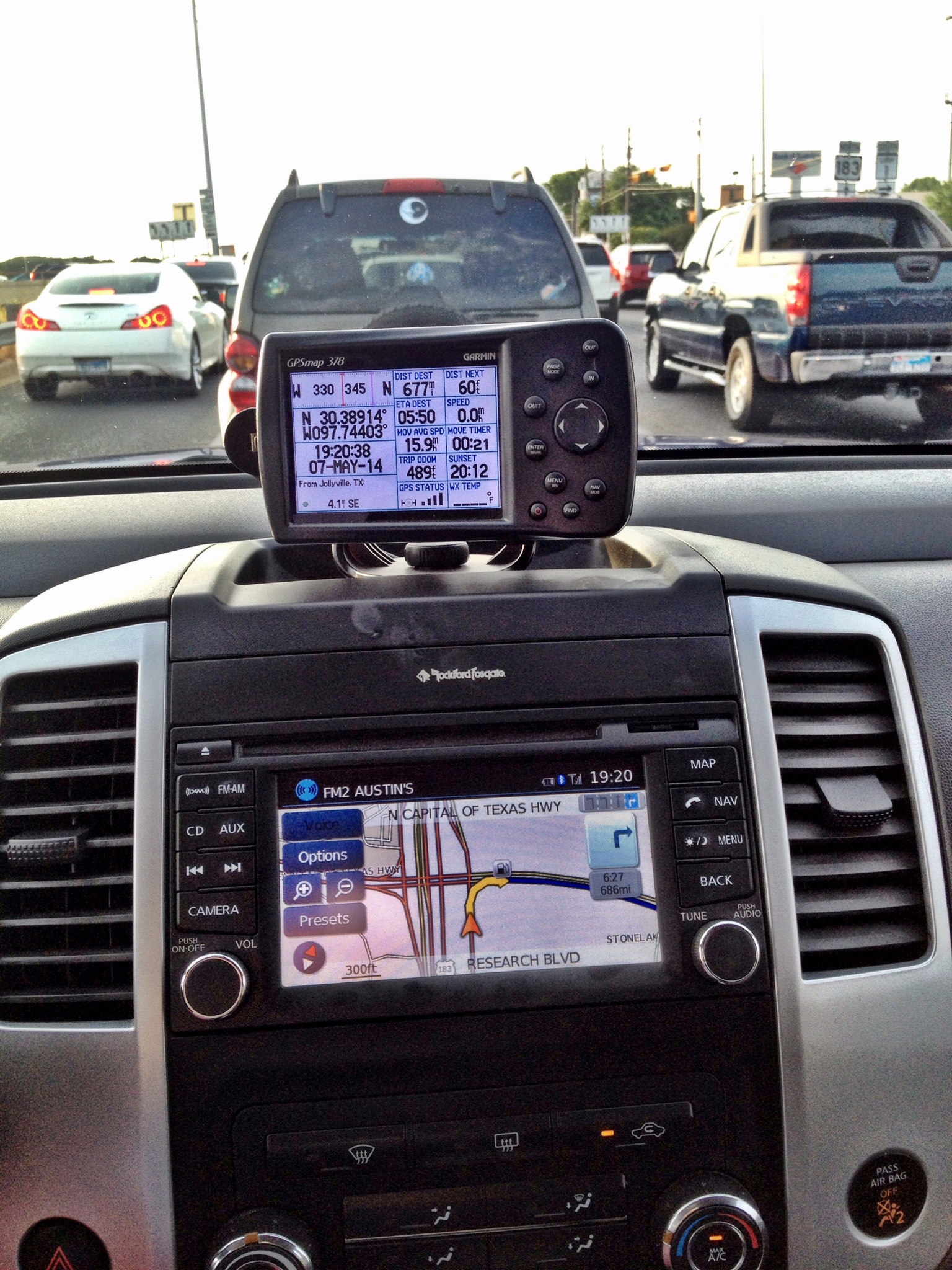

Freddy and the gang were worth every minute of the drive and their knowledge of lower-unit-less engines and boats is beyond awesome. I look forward to my return for a new engine.
Like I said in the previous post, I was going to do the exact same thing to this boat that I had done to the blue one. The SeaArk had a slight V in the Hull and I decided that needed to be addressed first. I had 4”x 4” 90 degree angle aluminium welded into the ribs to create a flat surface to build the flooring on. The flooring was Cedar planks that I sanded, epoxied, sanded, epoxied, sanded, epoxied and then sanded one more time with a final coat of spar varnish for the UV protection. I love wooden boats. My grandfather used to build them. I couldn’t not have the wood floors again, however, they are a huge pain in the ass to fit. I’m a huge fan of brute force and ignorance and in my diving days solved many problems with the idea that if a hammer wasn’t working a bigger one would. Fortunately, I was able to use the same tools my grandfather had used in his boat building; unfortunately his knowledge and experience did not magically pass through the tools as I had hoped it would. He died many years ago and I thought of him a lot while using them mostly during my many moments of frustration in not being able to beat the wood into submission with a larger hammer. The floors look great, however I can see every moment of frustration when my patience (or lack thereof) got the better of me. Guests don’t seem to mind.
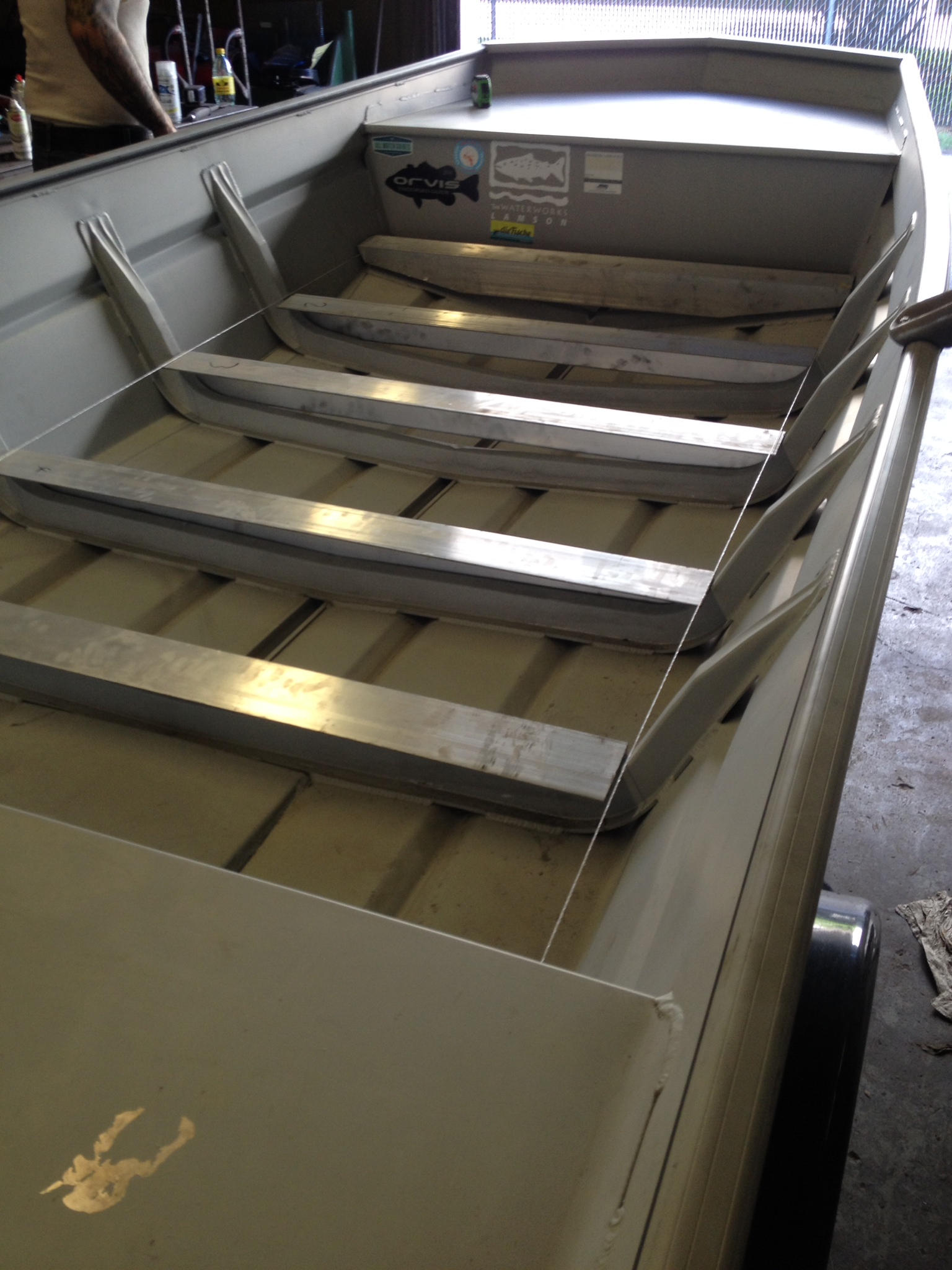
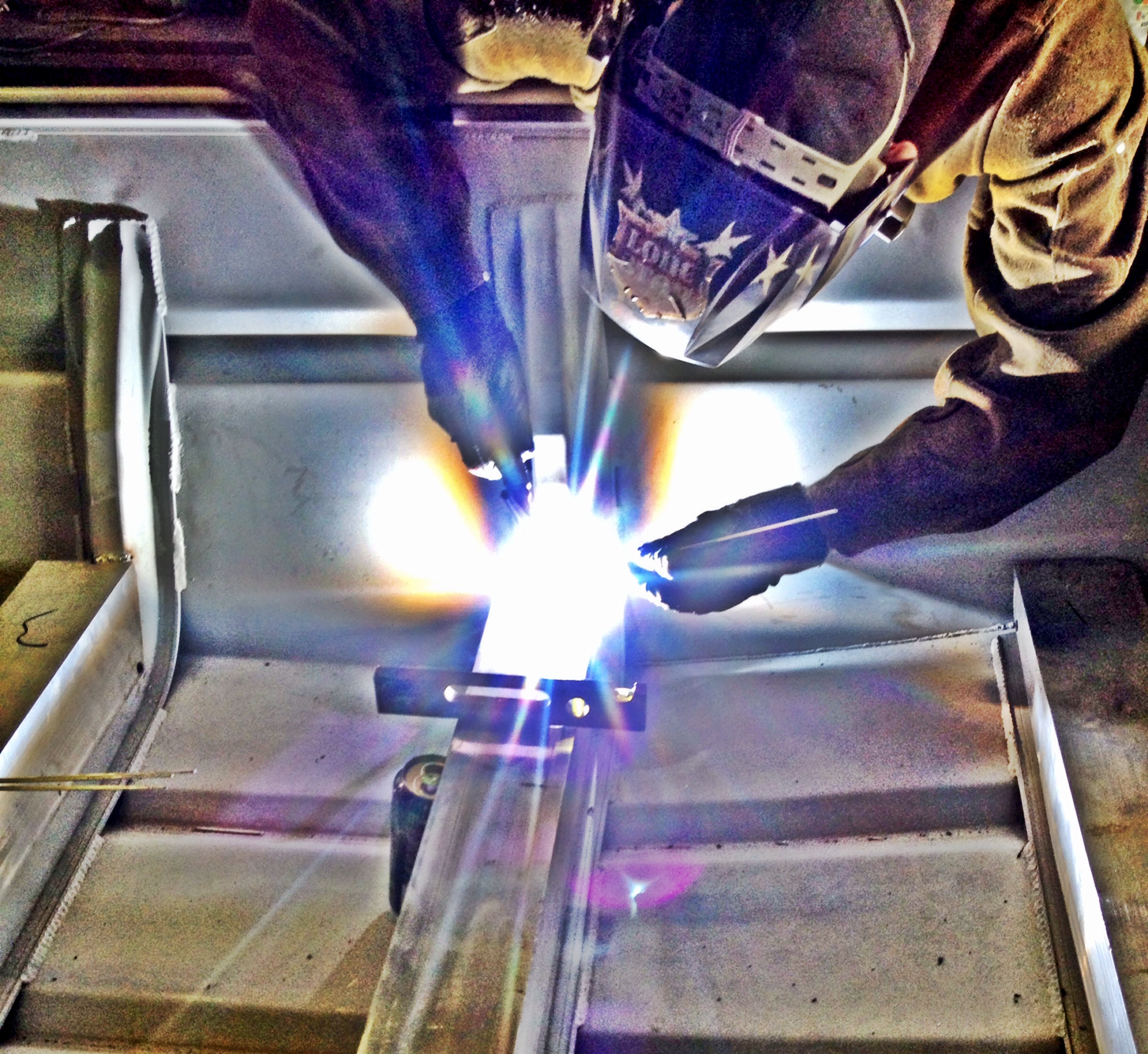
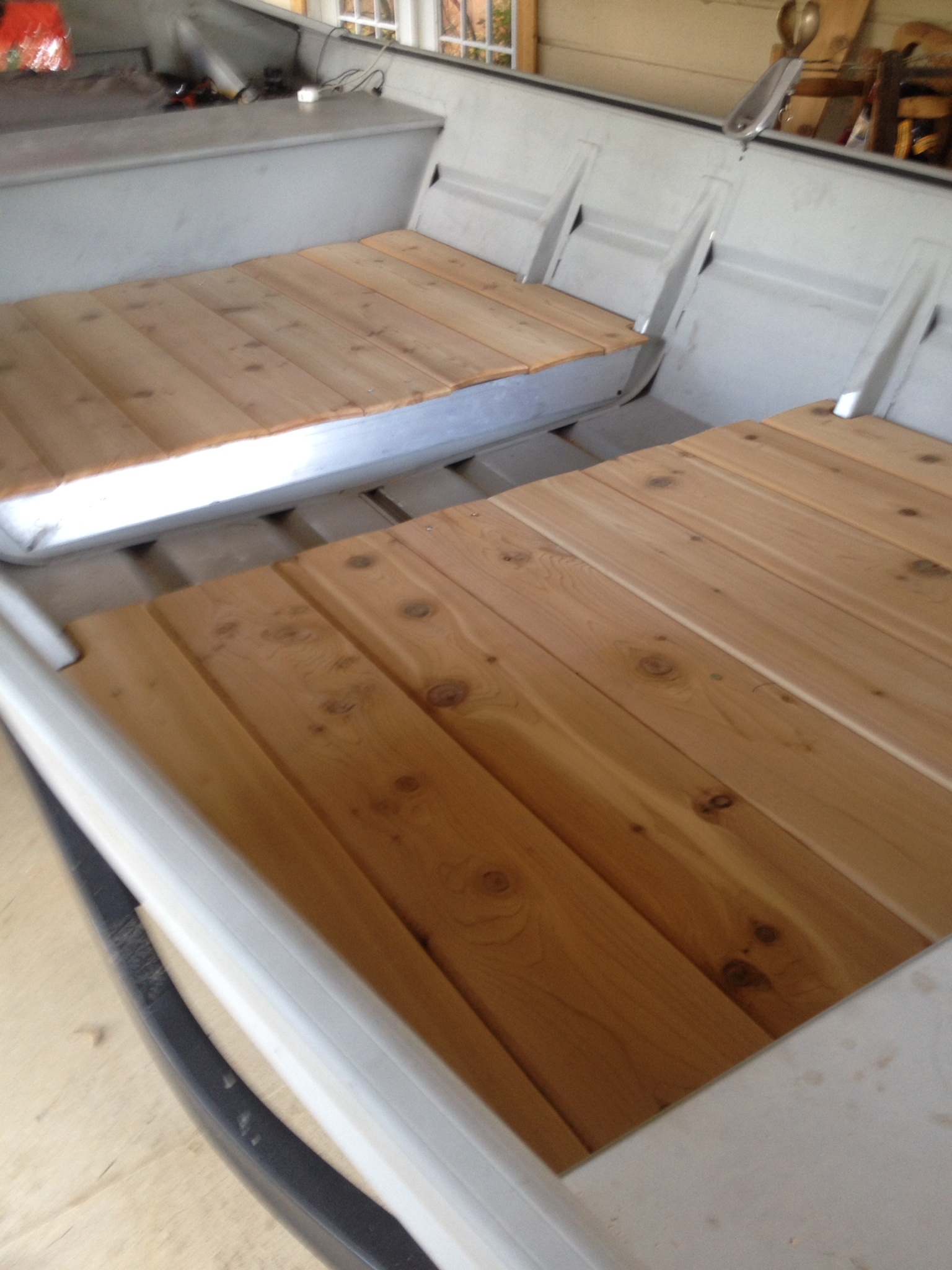

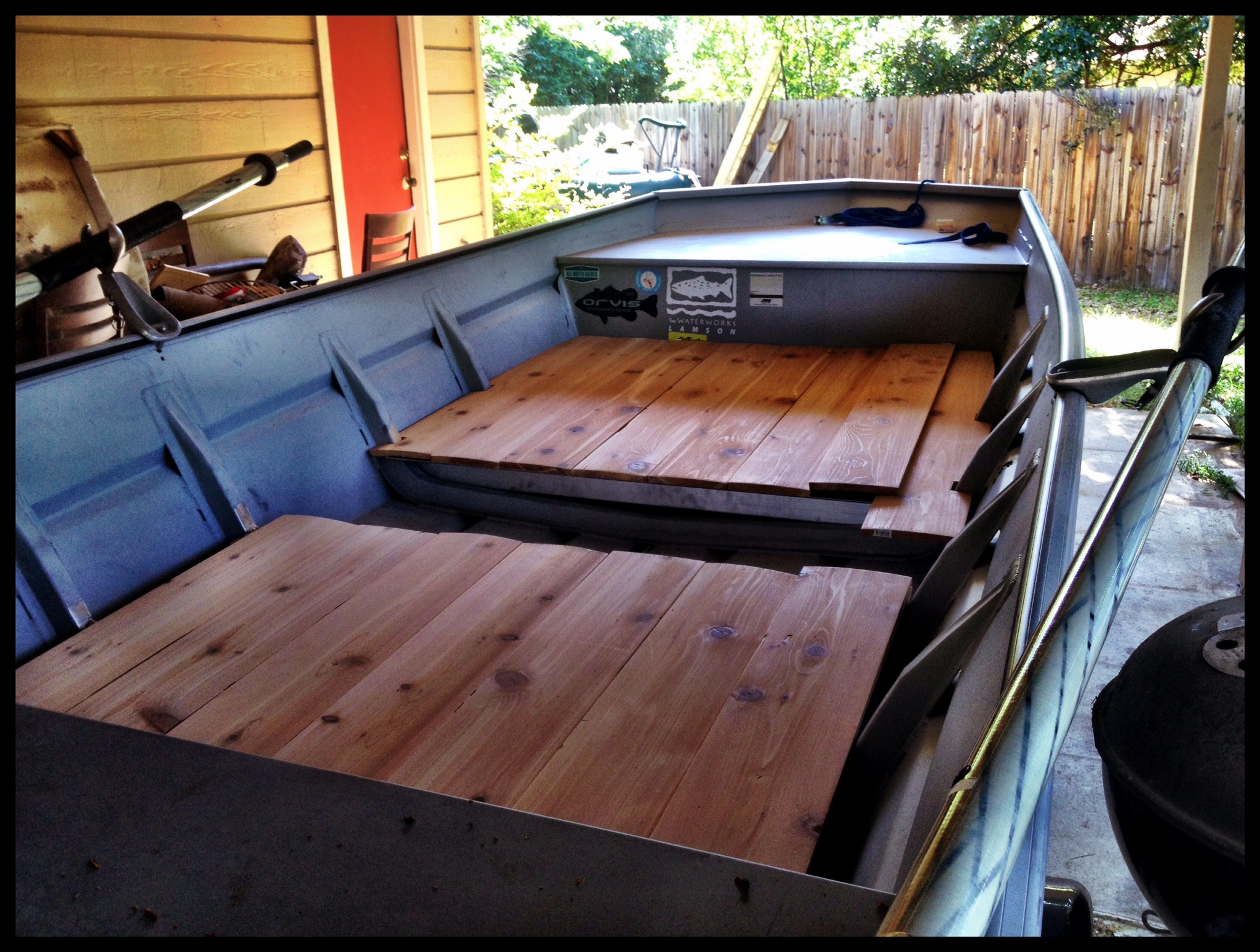
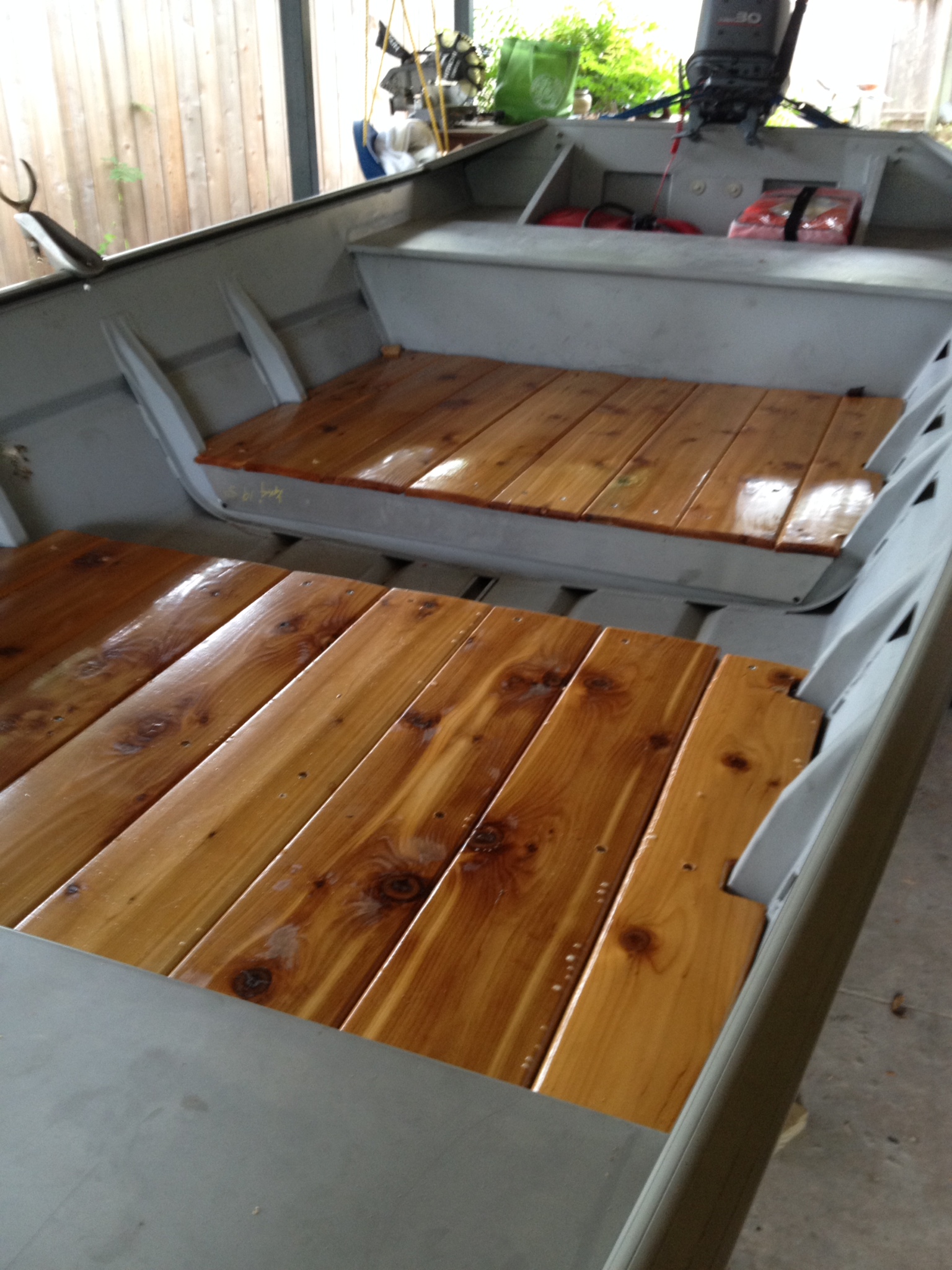
Supervision a year later...
Once the side pieces were cut and fitted to the ribs of the boat the rest went pretty quickly. I also can’t help but to think of my daughter, Poppy, who supervised the last boat, she was only a few months old and was pretty easy to occupy. She’s now almost 2 and has ZERO ability to sit and keep my company.
So that’s the floors. I was, at first, going to do lean bars and knee braces however after the first couple trips I’ve found out they aren’t really needed. It’s my opinion that maybe they create a false since of security for the anglers and without them my clients seem to have a better awareness of themselves and their movements while in the boat as long as I communicate my intentions while on the oars which is better for a lot of reasons. Speaking of the oars, I also didn’t have to create the “frame” like I had before. Oar locks u-bolt directly to the gunwales, which I need to move about a foot forward (boat forward) to give the front guy a little more room.
I, of course, have a laundry list of things to do still with rod holders being the first and some sea deck type stuff for the front casting platform (it gets hot) but since the boat was new there was no need to paint and do all that other nonsense that kept me so busy on the last project. Having the blue boat in my past made doing this boat so much easier, mainly because it was new…
Please contact me with any questions that I most likely did not answer. Alvin, JD and I would be more than happy to share what we’ve learned. We all run different rigs each having their own pros and cons.
Enjoy,
AWG
Dressing for Success: Or at least being able to stay on the water without suffering from heat exhaustion.
While Alvin and JD get to escape the summer heat of Texas, the rest of us will still run trips in the usual manner, however we’re going to be a little more inclined to do “half days” as opposed to the “full day trip” focusing on the early morning and late evenings.
During the next couple months we (as guides and fisherman) expect the brutal heat while on the water and do everything we can to prepare ourselves for it. Many of us guide and have “real jobs” on the side. Our preparation for the heat of the day not only keeps us fishing and guiding but allows us to not need a day off from our ‘day on the water’ to recuperate. Clients that show up dressed for the sun and heat in my experience catch more fish because they are able to fish hard from the first cast to last cast. Sun block, while an important part of the equation, can only go so far.
While on the water whether I’m fishing or guiding during the summer, you’ll find me covered from head to toe in clothing. Big straw hats, Buff sun masks, long sleeve shirts, pants and (yes, gloves). I’ve hyperlinked what I’m wearing in the picture. It seems to counter common sense that wearing so much clothing when its 105 will help keep you cool but it does. With the advances in outdoor clothing these technical garments create a barrier from the sun and “wick” moister (perspiration) in a way that you actually sweat less and what you do sweat evaporates in a more controlled manner. I’m not going to “cut and paste” a bunch of scientific evidence into this article as it is my experience that when I dress in this manner I’m a better guide for my clients and a better husband/father when my day on the water ends and the real work starts upon getting home.
Proper hydration isn’t something you can fix the day of. We all should be drinking water on a day-to-day basis. Bottled water won’t solve a dehydration or volume depletion problem the day of and while on the water, it can actually create serious complications (wearing my paramedic hat now) by flushing out electrolytes that well, are pretty damn important to being alive. As a medic this time of year we see a lot of people that don’t drink enough water on a day to day basis only to have it bite them in the ass after a full day in the sun. I’ve seen some scary cardiac rhythms associated with dehydration in “normal enough folks” that could have been avoided by just drinking a normal amount of water during the days before and wearing appropriate clothing. Shorts and t-shirts won’t cut it.
I think we all could easily drop a small fortune on gear without out a second thought. Personally it doesn’t take much to convince me that some shiny object to replace my perfectly good “older” shiny object is a must have for an upcoming trip (I’ve got a few coming). If you look at clothing as “gear” than it’s easy to justify a couple outfits for the elements. Rationally speaking it makes absolute sense to wear clothing that will keep you in the game longer whether it’s the trip of a lifetime or an afternoon on the Lower Colorado River with us.
See ya on the water!
AWG
Jet Sled version 2
Clay loading up a rod after a successful first run
A little while ago I bought a project and I'm about to start the process again. Last time I had a lot of requests to write a build report and not having the platform to do so I used FB which was me just posting a lot of pictures with out much reporting or content. This time around I plan to use this site and as this begins to take shape write about it.
So…the last project was a Jon or John boat with an outboard jet drive. From now on I’m just going to refer to these boats as Jet-Sleds. My first Jet-Sled (V1) was a riveted Alumacraft 1432 (14 feet long and 32” on the bottom) with an old Evinrude 25 hp.
Somewhere on I-35 Fueling up on a Double Quarter pounder
I really was Just buying the engine for another boat so I really didn’t care if the boat leaked (it did) or what condition it was in (rough). If I could get it for the right price (I did) the engine wouldn't even need to run (it didn’t). I had done enough research and talked to mechanics, friends and who ever would listen. We were confidant that if it didn't run 800 bucks would fix that (it did). The boat was reborn, used for a while with friends then sold when I ruptured my Achilles tendon, which was fine, I wasn’t in love with the boat. She was a handful on the water and in no way conducive to guiding. She did however run like a scalded dog and had a unique look. I plan to fix the “handful” problem with waterline and will most likely shoot for the same look and outfit the V2 Jet-sled in the same manner.
I really enjoyed the last project and tolerated (very well I must say) all the “dude, when ya gonna be done so "WE" can go fish in it” or “dude, your OCD”. This project will most likely take longer. Jet-sled V1 came as a package deal…Boat, Motor and trailer, at present time I have none of what I need accept a clearer understanding of what worked and what didn’t, that and a line on a 40/30 Yamadog.
Poppy supervising while I work, She's 18 months now so this wont work.
Stay tuned sports fans I’m looking forward to this project and sharing it on this web sites blog
Enjoy, tight lines and shallow running boats.
Winston





